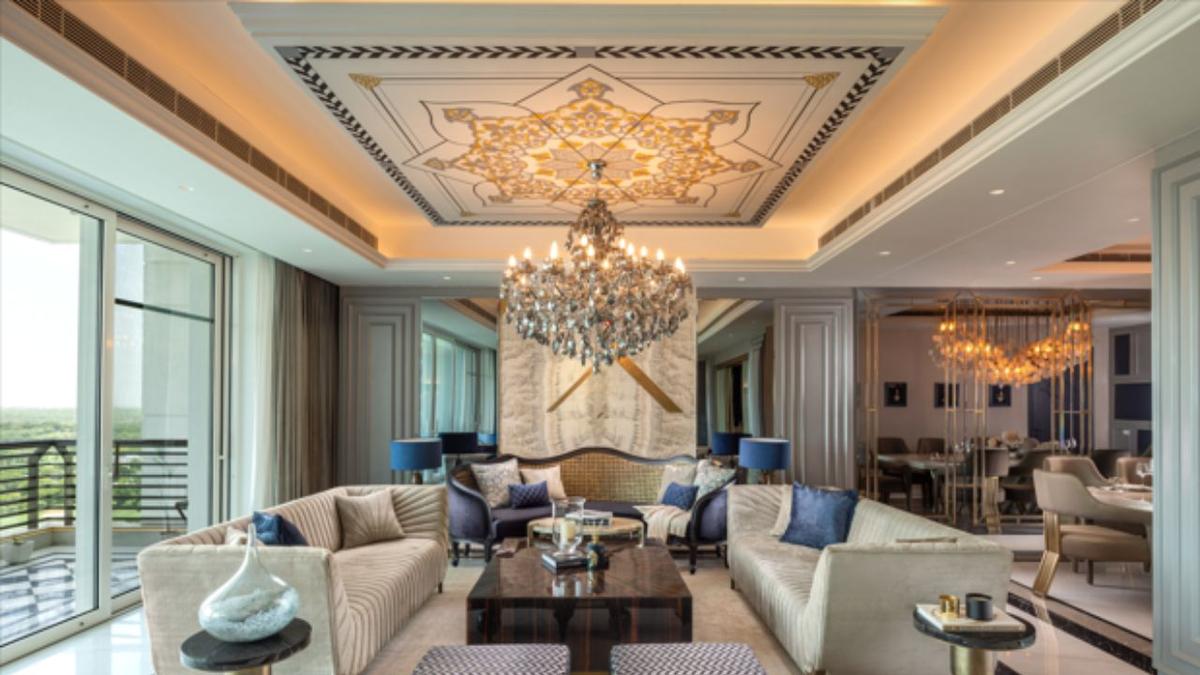Often touted as the fifth wall, the ceiling in today’s homes has become a defining design element in modern homes. “They are no longer just a functional element but visual canvases that add personality, drama, and a sense of completeness to a space. A well-designed ceiling has the power to transform the ambience, making a room feel more dynamic, intimate, or expansive depending on the design intent,” says Sonam Gala Gosalia, senior associate designer, Kiran Gala & Associates.
Historically, too, ceilings were never left plain, whether in ancient temples or palaces. “Step into a Rajasthani palace and the ceiling dazzles with gold leaf, narrating stories of gods and dynasties; walk through a Chettinad mansion and the wooden beams overhead tell you of lineage and craft. In today’s homes and workplaces, this role has only deepened. Where walls are increasingly minimal and floor plans open, the ceiling becomes the perfect overarch. It defines the style of a room instantly, brings cohesion to disparate elements, and creates a sense of scale,” says Swathy Sivaraman, CEO & principal architect, Storeyboard Design
What the ceiling trends say
Needless to mention, the ceiling is also a significant element that conceals lighting, HVAC systems, acoustics, and so on. Some of the key aspects of ceiling design depend on factors like the overall scale and height of the room, natural light availability, the purpose of the space, and the design language of the interiors. The key is to strike the right balance; while the ceiling should stand out, it must be cohesive with the flooring, walls, and furniture to avoid overwhelming the space. “As with all things design, it is about the right proportions with respect to the available height. We always integrate lighting early, pick materials which don’t require much maintenance, and ensure the ceiling talks to the rest of the room from a design standpoint,” says Huzefa Rangwala, co-founder and principal designer at MuseLAB and MuseMART. It is imperative that the planning of ceiling design, along with lighting, HVAC, automation, fire and security systems, is done hand-in-hand.
From geometric grids and layered woodwork to metallic accents and coffered patterns, the options to design statement ceilings are unending. There is also a growing emphasis on mixing textures, like combining wood with mirrors, stone, or fabric panels. “The recent resurgence of maximalism encourages bold, unique design choices, and a statement ceiling fits this ‘more-is-more’ philosophy perfectly. Incorporating bold colours and patterns, diverse materials like acoustic panels, metallic finishes, innovative lighting, futuristic integration with integrated speakers and hidden projectors have become popular,” says Nayan Shah, founder of Palindrome Spaces.
So today, ceilings are no longer confined to sterile white plaster; they are being reimagined as sculptural forms, woven textures, and canvases of colour. “Natural and sustainable materials like rattan, bamboo, and engineered wood are reclaiming their place overhead, bringing warmth and tactility. Fluid geometries and soft curves are turning ceilings into floating art installations. Light is being treated not as an accessory but as a material in itself with linear profiles and concealed systems casting glows that shape volume and mood,” adds Sivaraman.
Here are six distinct statement ceilings that are true showstoppers in their own right:
Kiran Gala & Associates
In this project, the ceiling becomes a bold architectural feature that ties the dining and lounge areas together. “The design employs a coffered grid pattern in warm-toned wood, set against a muted grey base, creating both rhythm and depth. The reflective quartz marble inlays within some panels enhance play and add an element of sophistication,” says Gosalia. Spanning across a generous open-plan layout, the ceiling brings a sense of cohesion while also highlighting each functional zone. The thought process was to create a ceiling that feels integral to the design narrative rather than a mere overhead surface. The combination of wood, marble, and proportioned grid work ensures that the ceiling feels sculptural yet timeless.
A design by Kiran Gala & Associates.
CraftCanvas
Jaipur’s Museum of Meenakari Heritage has five hand-painted ceilings, each spanning 250-400 sq.ft., creating nearly 1,500 sq.ft. of continuous painted surface. These are designed as immersive focal points for visitors to look up and encounter a story. “We adapted traditional miniature painting techniques to architectural scale, drawing freely from the Pahari School (especially the works of Nainsukh of Guler) and the Bundi School. Instead of using a prepared base, we worked directly on the wall’s limewash. This gave the surfaces a luminous quality, leaving no room for error. Painting on ceilings meant designing for a single-point perspective, the compositions had to make sense when viewed from any angle,” says Nisha Vikram, promoter, CraftCanvas. Each ceiling, with a distinct theme, was painted by artisans with heads craned up for months — an extraordinary feat. “The sheer scale demanded innovation; while miniatures are usually intimate (6×8 in), here details had to retain clarity and impact across spans of up to 30 ft. This project shows Indian miniature painting can live in contemporary architecture — as a living, adaptive language that speaks to both heritage and modern luxury,” she adds.
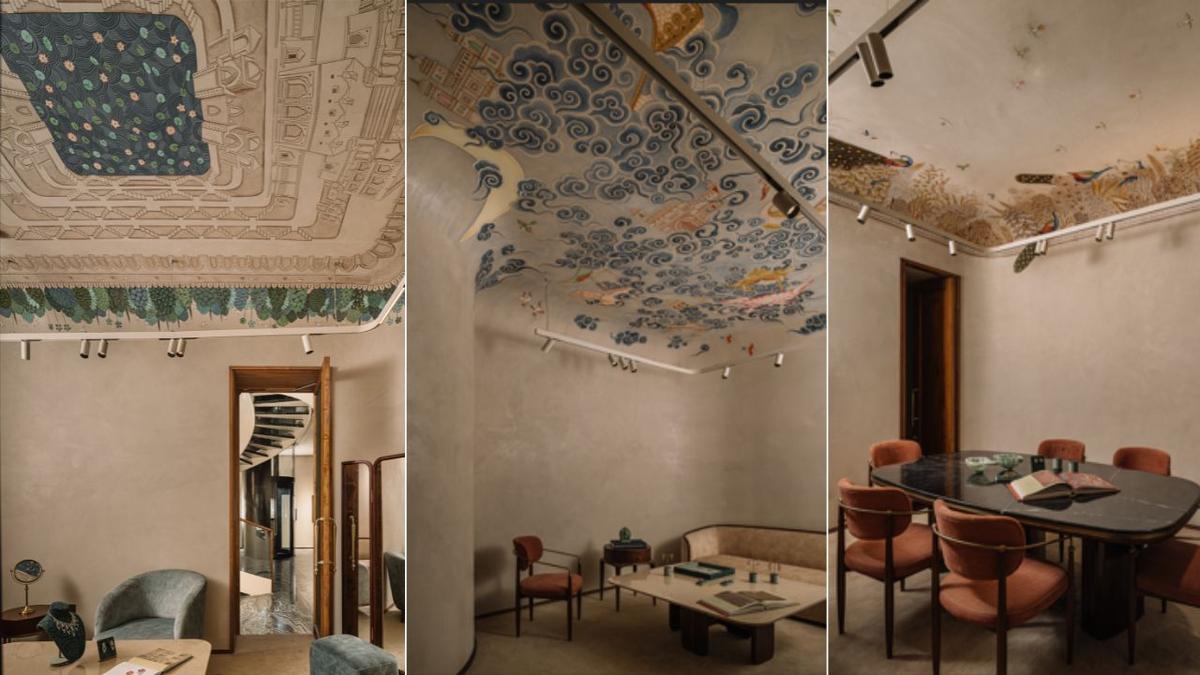
Ceilings designed by CraftCanvas.
Storeyboard Design
A bespoke installation, crafted from nearly a thousand dual-toned glass elements, sweeps across this ceiling like the meandering rivers of India. “Each wave-like piece, suspended on fine stainless-steel strings and layered at varying heights, ripples through 200 sq.ft. of volume, creating an immersive sense of movement and flow. The AC ducts were aesthetically covered with CNC-cut metal jalli to add the perfect frame to the ceiling while remaining fully functional for airflow. To heighten its luminosity, the chandelier is set against a wooden ceiling clad in silver foil, transforming it into a reflective canvas where glass and light merge seamlessly,” says Sivaraman. The overall environment, accented by beige suede laser-cut wall panels, beaded curtains, and gold-toned furniture, creates a serene yet opulent setting where the ceiling takes centrestage.
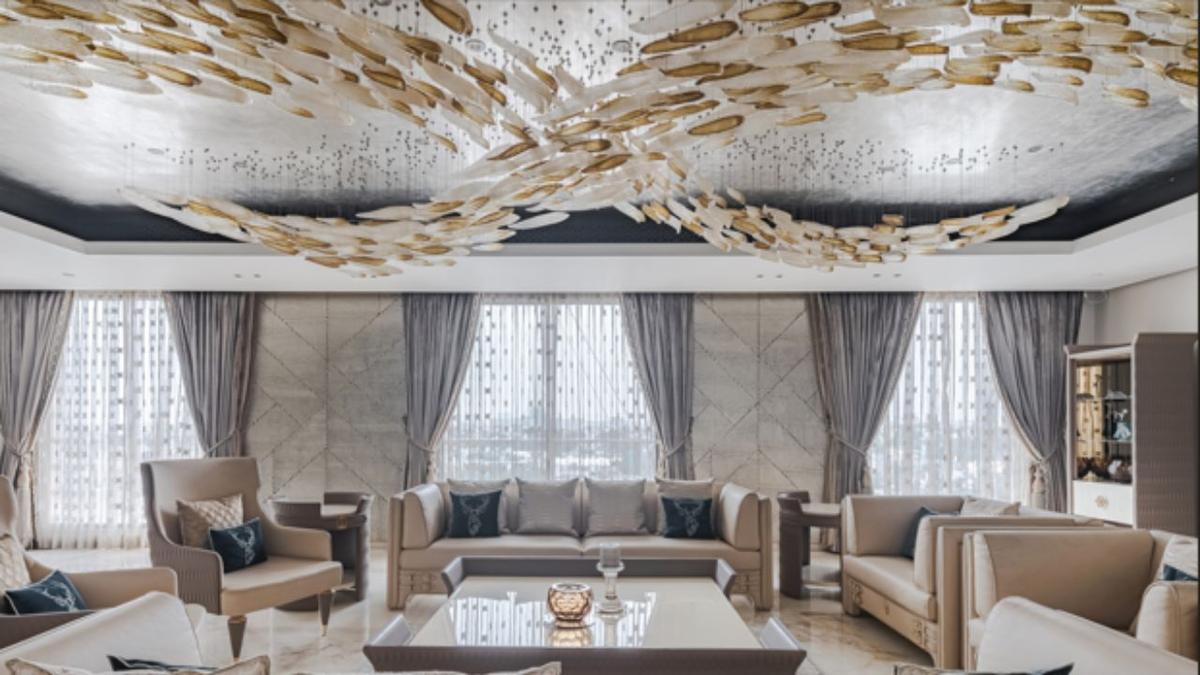
A ceiling by Storeyboard Design.
UDC Homes
This exquisite ceiling design using wallpaper is a modern interpretation of Mughal motifs and a testament to timeless elegance. “Inspired by the intricate patterns of a delicate scarf, it transforms the fifth wall into a canvas of artistry. The hand-painted detailing, reminiscent of a royal ‘dastarkhwan’, elevates the space, weaving a story of heritage and luxury,” says Leena Monga, founder of Agnom Designs. Spanning the entire space, the ceiling wallpaper was chosen to complement the room size, ensuring balance without overwhelming it. “High-quality wallpaper materials were used for durability and seamless finish. Strategic lighting was integrated to highlight the ceiling’s details, creating a dramatic yet harmonious aesthetic. The result is a ceiling that elevates the interior with character and sophistication,” says Neha Jain, co-founder, UDC Homes.
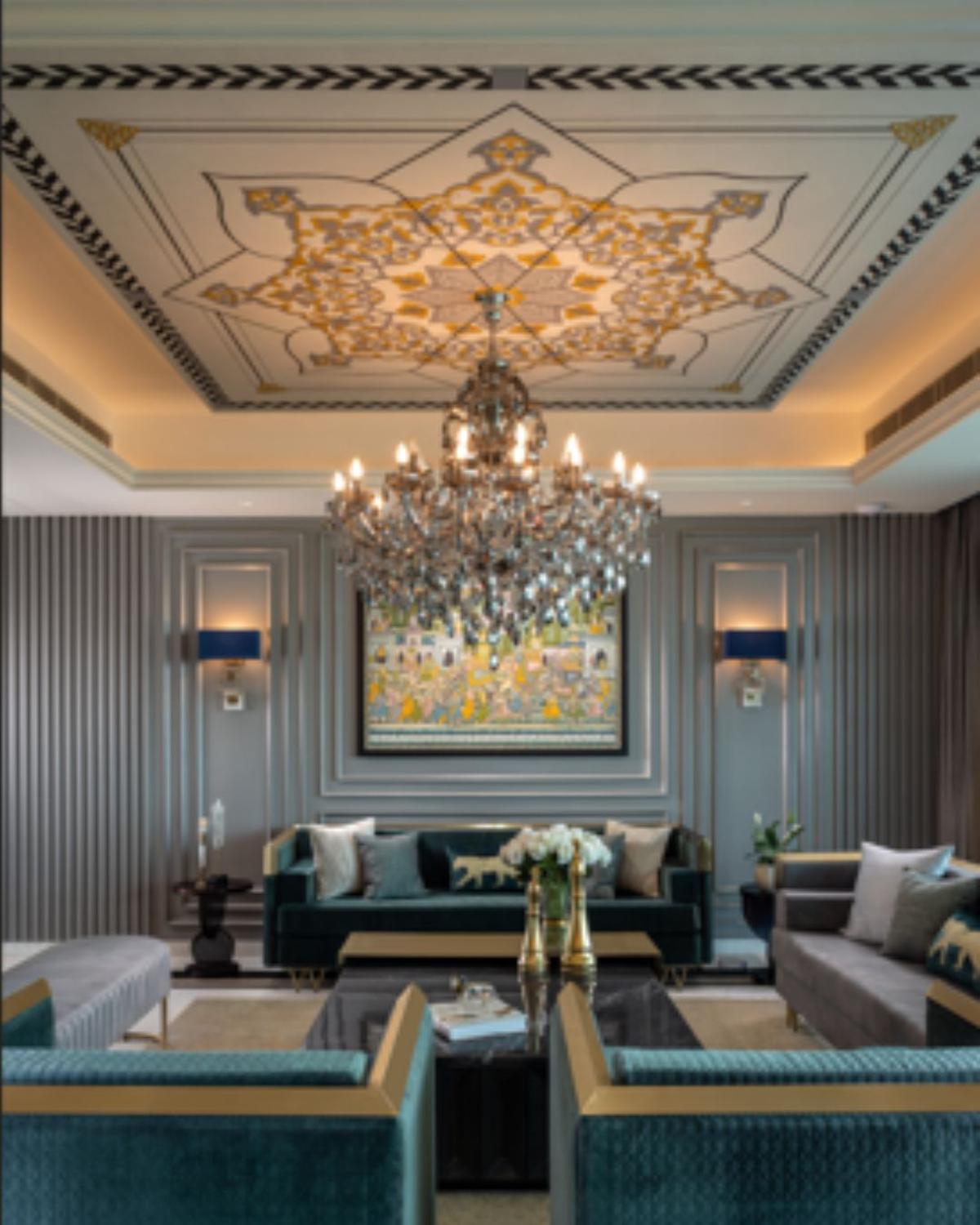
A ceiling by UDC Homes.
MuseLAB
This 3,000-sq.ft. home takes the classic gingham pattern and reimagines it through marble inlays, cabinetry, lighting, and ceiling details. In the master bedroom, the ceiling becomes a highlight with a bold two-tone chequered design made from distressed and deep-toned veneers. Playful lines cut through the grid, adding balance and breaking monotony, while the ceiling fixtures are seamlessly planned within the pattern. “Inspired by retro picnic cloths and quilts, the design brings a touch of nostalgia and quiet elegance to the space,” says Jasem Pirani, co-founder and principal designer, MuseLAB and MuseMART.
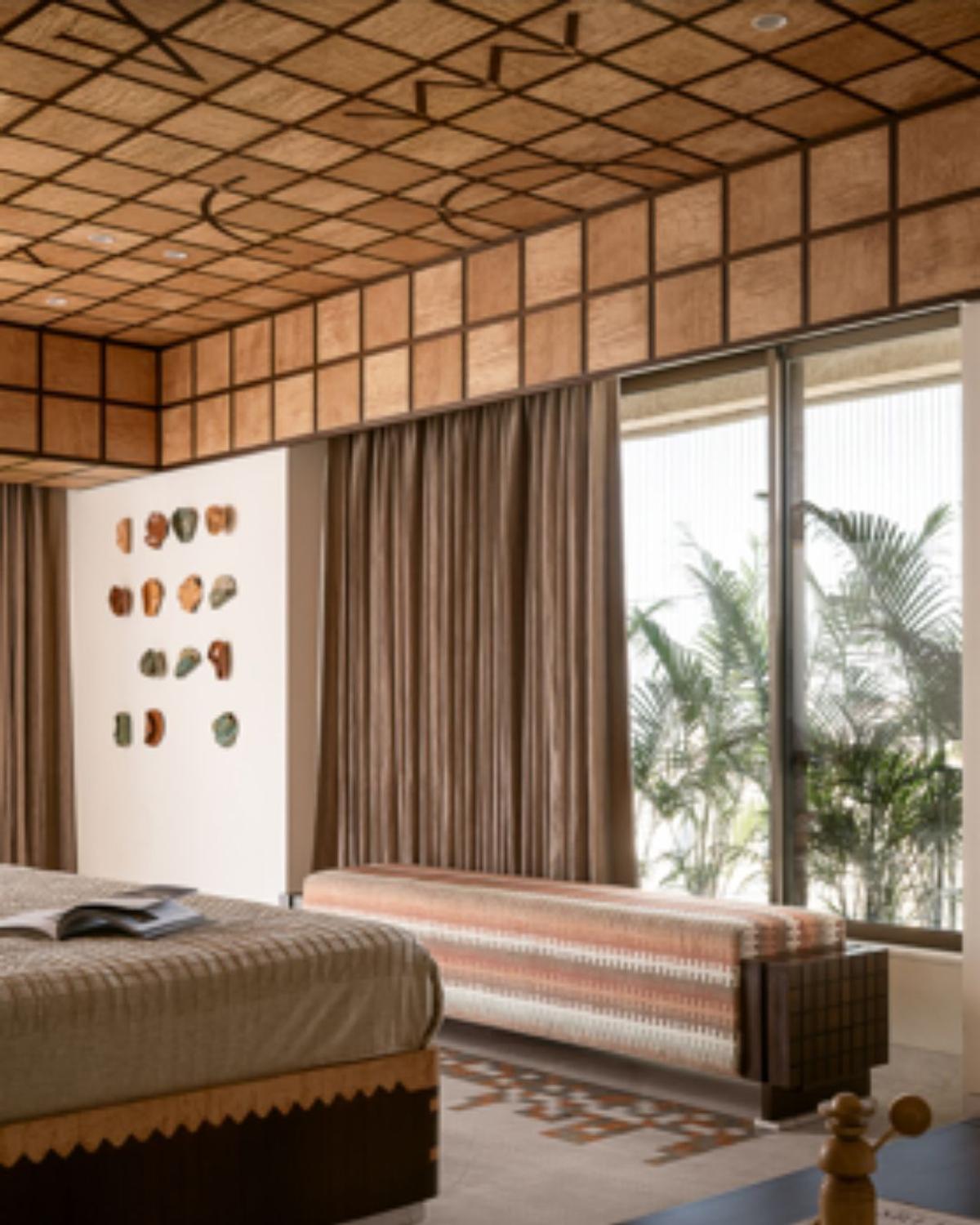
A design by MuseLAB.
Palindrome Spaces
Grey, gold, emerald green, whiskey brown and mustard yellow make a grand introduction to several zones of the home, displaying minimalism within maximalism through the combination of tropical shaded murals on the ceilings. “The master bath is bedecked with a luxurious green marble counter and brought alive with a deep green hand-painted ceiling by the wall mural artist Rashmil,” adds Shah. The walk-in wardrobe is a trip to the tropics, with a bold and vibrant hand-painted ceiling and floor-to-ceiling glass on wardrobes. The powder room with bright floral motifs painted on the ceiling is a sanctuary of biophilia; the gold-framed Baroque mirror on a black countertop exudes the feelings of nostalgia of a bygone era. The bedroom ceiling is a kaleidoscope of colour with white herons set amid a pink backdrop and theatrics of light; all packed into a snug space.
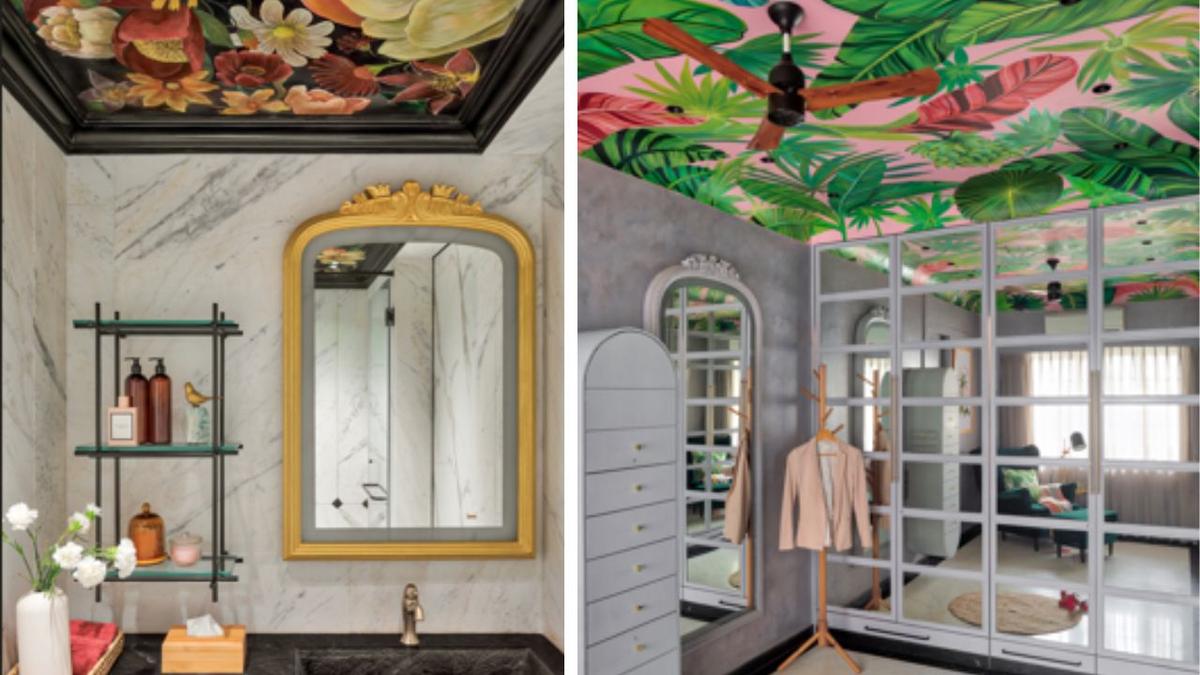
Ceilings by Palindrome Spaces.
The Bengaluru-based freelance writer is passionate about all things design, travel, food, art and culture.


